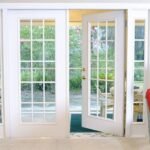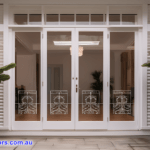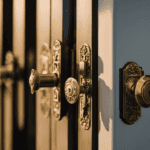The Timeless Appeal of French Doors
French doors have long been admired for their timeless appeal and ability to add a touch of elegance to any space. Let’s look at these iconic doors’ brief history and origin.
A Brief History of French Doors
French doors trace their roots back to the 17th century and are believed to have originated in France during the Renaissance period. They were initially inspired by the casement windows of the time, which featured multiple panes of glass hinged together.
The design of French doors evolved over the centuries, reflecting the changing architectural styles and tastes of different eras. Initially, these doors were made with solid wood frames and glass panes, allowing natural light to flood into interior spaces. Over time, manufacturing techniques and materials advancements led to more intricate designs and variations.
The Origin of French Doors
The concept of French doors can be traced back to the influence of Italian architecture on French design. During the Renaissance, Italian architects sought to merge the indoors with the outdoors by incorporating large openings. This influence, combined with the French love for symmetry and elegance, gave birth to the concept of French doors.
French doors quickly gained popularity and became synonymous with sophistication and style. They were prominently featured in grand mansions, palaces, and stately homes across Europe. Notable historical examples include the Palace of Versailles in France and the Château de Chambord.
Over time, French doors found their way into various architectural styles, from classical to contemporary. They continued to captivate homeowners with their ability to create a seamless connection between indoor and outdoor spaces, allowing abundant natural light to enter.
To learn more about French doors’ evolution and influence on architecture, check out our article on the origin, early designs, and evolution over the centuries.
French doors have come a long way since their inception, but their charm and allure remain as strong as ever. They are popular for homeowners looking to enhance their living spaces’ aesthetic appeal and functionality.
French Doors in Modern Architecture
With their classic elegance and timeless charm, French doors have seamlessly transitioned into modern architecture. They bring a touch of sophistication to contemporary designs while enhancing the overall aesthetic appeal. Let’s explore how French doors make an impact on modern architectural design.
Bringing Classic Elegance to Contemporary Designs
French doors have a rich history and have been used in architecture for centuries. Their origin and early designs can be traced back to the Renaissance period, where they were used to create a sense of grandeur and connection between interior and exterior spaces. Over the centuries, French doors have evolved in design and function, adapting to changing architectural styles and trends. To learn more about the fascinating history of French doors, you can visit our article on the origin of early designs and evolution over the centuries.
In modern architecture, French doors continue to be highly sought after for their ability to infuse spaces with classic elegance. They add a touch of sophistication to contemporary designs, serving as a focal point and enhancing the overall aesthetic appeal of a space. The timeless beauty of French doors complements various architectural styles, whether it’s a sleek and minimalist design or a more traditional and ornate structure. The versatility of French doors allows them to seamlessly blend into different design concepts, making them a popular choice among homeowners and architects alike.
Impact on Indoor-Outdoor Flow
One of the key reasons French doors have become synonymous with modern architecture is their ability to connect indoor and outdoor spaces effortlessly. French doors create a seamless transition between the interior and exterior, blurring the boundaries and allowing for a harmonious flow between the two areas. This connection enhances a space’s overall functionality and allows homeowners to enjoy a closer connection with nature.
By incorporating French doors into modern architectural designs, architects and homeowners can maximize the potential of their living spaces. The abundant natural light that floods through the doors creates a warm and inviting atmosphere, making the interior spaces feel brighter and more spacious. Additionally, French doors provide panoramic views of the surrounding landscape, allowing homeowners to appreciate the beauty of their outdoor surroundings from the comfort of their homes. To explore some notable historical examples of the influence of French doors on architecture, check out our article on influence on architecture and notable historical examples.
In conclusion, French doors have significantly impacted modern architectural design. They bring classic elegance to contemporary spaces and create a seamless connection between indoor and outdoor areas. Their ability to enhance natural light, expand visual space, and provide breathtaking views makes them an integral element in modern architectural concepts. Whether it’s a sleek and minimalist design or a more traditional approach, French doors continue to be a beloved choice for homeowners and architects who seek to elevate the beauty and functionality of their living spaces.
Enhancing Natural Light and Views
French doors have long been admired for their ability to enhance natural light and provide stunning views of the outdoors. They bring a sense of openness and connection to the surrounding environment, making them popular in modern architectural designs.

Expanding Visual Space
One of the remarkable benefits of French doors is their ability to expand visual space. These doors are typically made with large glass panels, allowing abundant natural light to flood the interior. The seamless transition from the inside to the outside creates an illusion of a larger area, making the room feel more spacious and open.
By incorporating French doors, you can create a sense of airiness and bring the beauty of the outdoors into your home. The increased natural light and expanded visual space can make any room feel brighter, more inviting, and conducive to a comfortable living environment.
Connecting Interior and Exterior Spaces
French doors are a beautiful connection between a home’s interior and exterior spaces. They blur the boundary between the two, allowing a seamless flow from indoor to outdoor living areas. By opening the doors, you can create a harmonious transition, extending your living space to the outdoors.
These doors are precious in homes with gardens, patios, or scenic views. They provide an uninterrupted view of the surrounding landscape, allowing you to enjoy the beauty of nature from the comfort of your home. Whether hosting a gathering, enjoying a quiet evening, or simply appreciating the view, French doors provide an elegant and functional solution for connecting your interior and exterior spaces.
To further explore French doors’ impact on modern architectural design, check out our article on influence on architecture. It delves into how French doors have shaped and inspired historical architectural trends.
French doors not only enhance natural light and views but also offer versatility in design. In the next section, we’ll explore the styles of French doors, from traditional to contemporary, and how they can complement various architectural aesthetics.
Versatility in Design
French doors are renowned for their timeless elegance and ability to blend with various architectural styles seamlessly. They offer a versatile design option that can be adapted to traditional and contemporary settings. Let’s explore the two main design categories for French doors: traditional and contemporary.
Traditional French Doors
Traditional French doors are characterized by their classic design elements, which have remained popular over the years. These doors typically feature multiple divided glass panels, known as “lights,” separated by muntins or wooden strips. The glass panels allow natural light to flow into the space, creating an open and airy ambience. Traditional French doors often have intricate detailing on the framing and may incorporate decorative elements such as scrollwork or bevelled glass.
These doors are commonly found in historical buildings and homes where preserving architectural integrity is paramount. Traditional French doors add a touch of elegance and charm to any space, making them a popular choice for homeowners seeking to capture a timeless aesthetic. For a deeper understanding of French doors’ history and early designs, check out our article on the origin and early designs.
Contemporary French Doors
In contrast to their traditional counterparts, contemporary French doors embrace a more modern and minimalist approach. These doors feature sleek lines, clean designs, and larger glass panels, allowing for maximum visibility and an unobstructed view of the surrounding environment. Contemporary French doors often have fewer muntins or may even be frameless, creating a seamless transition between indoor and outdoor spaces.
The minimalist design of contemporary French doors complements modern architectural styles, emphasizing simplicity and a connection with nature. These doors are designed to enhance the overall aesthetic of a space while providing ample natural light and views. For a closer look at how French doors have influenced modern architecture, refer to our article on the influence of French doors on architecture.
Whether you opt for the timeless elegance of traditional French doors or the sleek and modern appeal of contemporary French doors, both options offer a wide range of benefits. They can transform the look and feel of a space, creating a sense of openness and enhancing the overall design. By understanding French doors’ versatility and adaptability to different design styles, you can choose the option that best suits your taste and complements your home’s architectural aesthetic.
French Doors and Energy Efficiency
When considering the installation of French doors in your home, it’s important to understand their impact on energy efficiency. French doors can provide insulation and thermal performance benefits while offering eco-friendly options.
Insulation and Thermal Performance
French doors can contribute to your home’s overall insulation, helping regulate indoor temperatures and reduce energy consumption. The construction and materials used in French doors play a significant role in their insulation properties.
For optimal insulation, look for French doors with multi-pane glass, such as double or triple glazing. The air space between the glass panes is a barrier, reducing heat transfer and preventing drafts. Additionally, low-emissivity (low-E) coatings on the glass can enhance thermal performance by reflecting heat into the room during colder months and minimizing heat gain during warmer months.
To assess the energy efficiency of French doors, consider their U-factor and Solar Heat Gain Coefficient (SHGC). The U-factor measures the heat transfer rate through the door, with lower values indicating better insulation. The SHGC measures the amount of solar heat transmitted through the glass, with lower values indicating better heat resistance. Look for French doors with low U-factor and SHGC values to ensure optimal energy efficiency.
Eco-Friendly Options
Many homeowners are also interested in eco-friendly options for French doors. Choosing sustainable and environmentally friendly materials can contribute to reducing your carbon footprint. Look for French doors made from responsibly sourced wood or recycled materials.
Another eco-friendly option is considering French doors with energy-efficient features, such as those awarded ENERGY STAR certification. These doors have undergone rigorous testing and meet strict energy efficiency standards the U.S. Environmental Protection Agency set. ENERGY STAR-certified French doors can help you save on energy costs while reducing greenhouse gas emissions.
Additionally, consider the installation of weatherstripping and proper sealing around the door frame to enhance energy efficiency. These measures help to minimize air leaks and improve insulation, ensuring that your French doors contribute to an energy-efficient home.
Considering insulation, thermal performance, and eco-friendly options, you can make informed decisions when selecting French doors for your home. Remember to consult with professionals and explore the options available to find the best fit for your needs. For more information on French doors, visit our articles on origin, early designs, and evolution over the centuries.
How Have French Doors Evolved to Impact Modern Architecture?
The invention of French doors has had a significant impact on modern architecture. These doors have evolved from their original designs to more energy-efficient and stylish options. They are now a popular choice for connecting indoor and outdoor spaces, bringing in natural light, and creating a sense of openness in modern buildings.
Maintaining and Caring for French Doors
Proper maintenance and care are essential to ensure that your French doors continue to enhance the beauty and functionality of your home. By following a few simple cleaning and maintenance tips and addressing common issues that may arise, you can keep your French doors looking and functioning their best for years to come.
Cleaning and Maintenance Tips
Regular cleaning is key to maintaining the appearance of your French doors. Here are some tips to keep in mind:
- Dust and debris removal: Use a soft, dry cloth or a feather duster to remove dust and debris from the surfaces of the doors. Pay attention to the corners and crevices where dirt can accumulate.
- Glass cleaning: For the glass panels of your French doors, use a non-abrasive glass cleaner and a lint-free cloth or newspaper to achieve a streak-free shine. Avoid using harsh chemicals or abrasive materials that could damage the glass.
- Frame and hardware cleaning: Wipe down the door frames and hardware with a damp cloth. If needed, use a mild soap or detergent diluted in water. Avoid using abrasive cleaners or scrub brushes that could scratch the surface.
- Weatherstripping maintenance: Inspect the weatherstripping around the doors and ensure it is clean and in good condition. If the weatherstripping is damaged or worn, consider replacing it to maintain proper insulation and energy efficiency.
- Lubrication of hinges and locks: Apply a small amount of lubricant to the hinges and locks of your French doors to ensure smooth operation. Use a lubricant designed for door hardware and follow the manufacturer’s instructions.
Remember to consult the manufacturer’s guidelines for specific cleaning and maintenance instructions tailored to your French doors.
Common Issues and Solutions
While French doors are generally durable and reliable, a few common issues may arise. Here are some potential problems and their solutions:
- Sticking or misaligned doors: If your French doors are sticking or not aligning properly, check for any obstructions in the tracks or hinges. Clean the tracks and hinges if necessary and tighten any loose screws. If the issue persists, consult a professional for further assistance.
- Drafts or air leaks: If you notice drafts or air leaks around your French doors, inspect the weatherstripping for damage or gaps. Replace any worn or damaged weatherstripping to improve insulation and energy efficiency.
- Condensation on glass: Condensation on the glass panels of your French doors can be a common occurrence, especially in humid environments. To reduce condensation, ensure proper ventilation in the room and use dehumidifiers if needed. Wiping away excess moisture regularly can also help prevent water damage.
- Scratches or dents: If your French doors develop scratches or dents, consult the manufacturer’s guidelines for recommended touch-up options. Some minor imperfections may be able to be buffed out or filled with appropriate materials.
By following these cleaning and maintenance tips and addressing common issues promptly, you can keep your French doors in excellent condition and enjoy their timeless appeal for years to come. For more information on the history and impact of French doors on modern architecture, check out our articles on the origin and early designs, evolution over the centuries, and influence on architecture.
I'm James Davis, a carpenter with eight years of experience in carpentry services, repairs, installations, renovations, and maintenance of interior doors. I have a diploma in carpentry and joiner trade from the Education Skills Australia Institute and take pride in delivering high-quality results to ensure customer satisfaction. I'm a blog writer for Octopus Doors Company and enjoy sharing my knowledge and tips on maintaining security measures and choosing the right door materials, paints, or handle styles. I specialize in custom-made interior doors and strive to make every home look fabulous. Contact me anytime for help with door-related issues.











